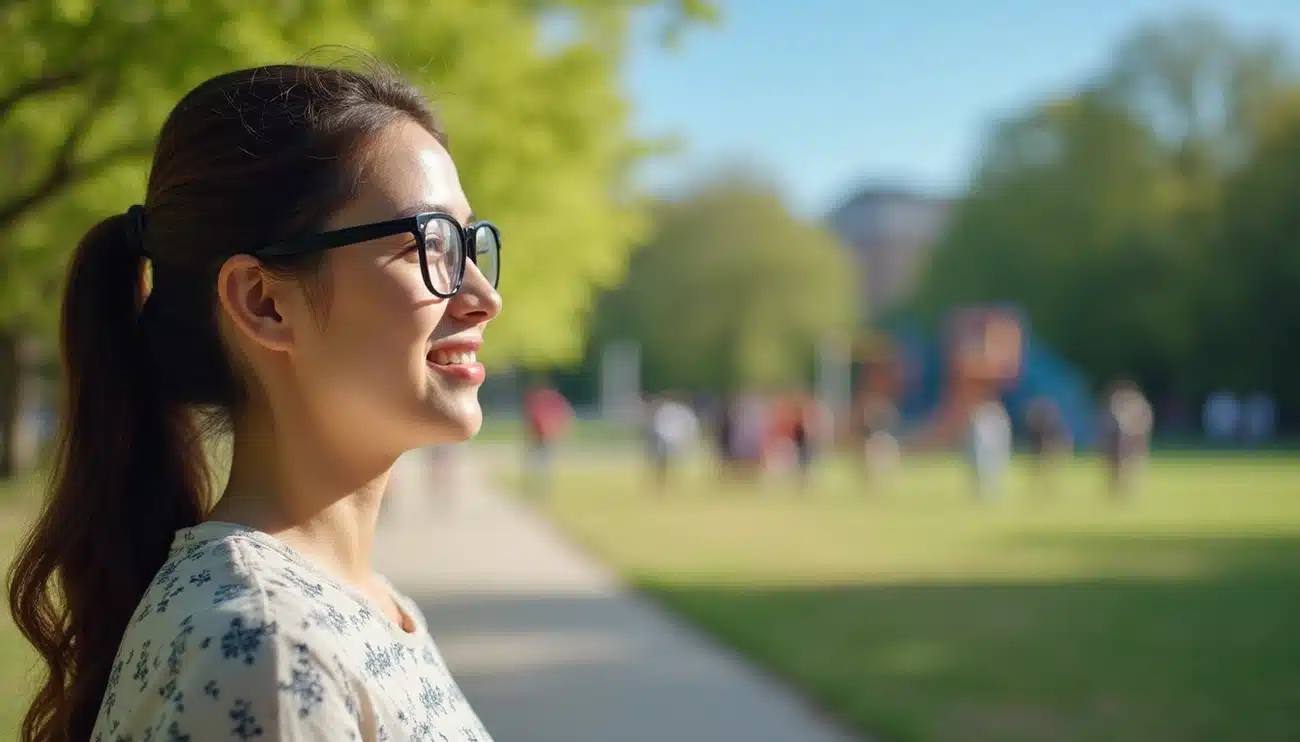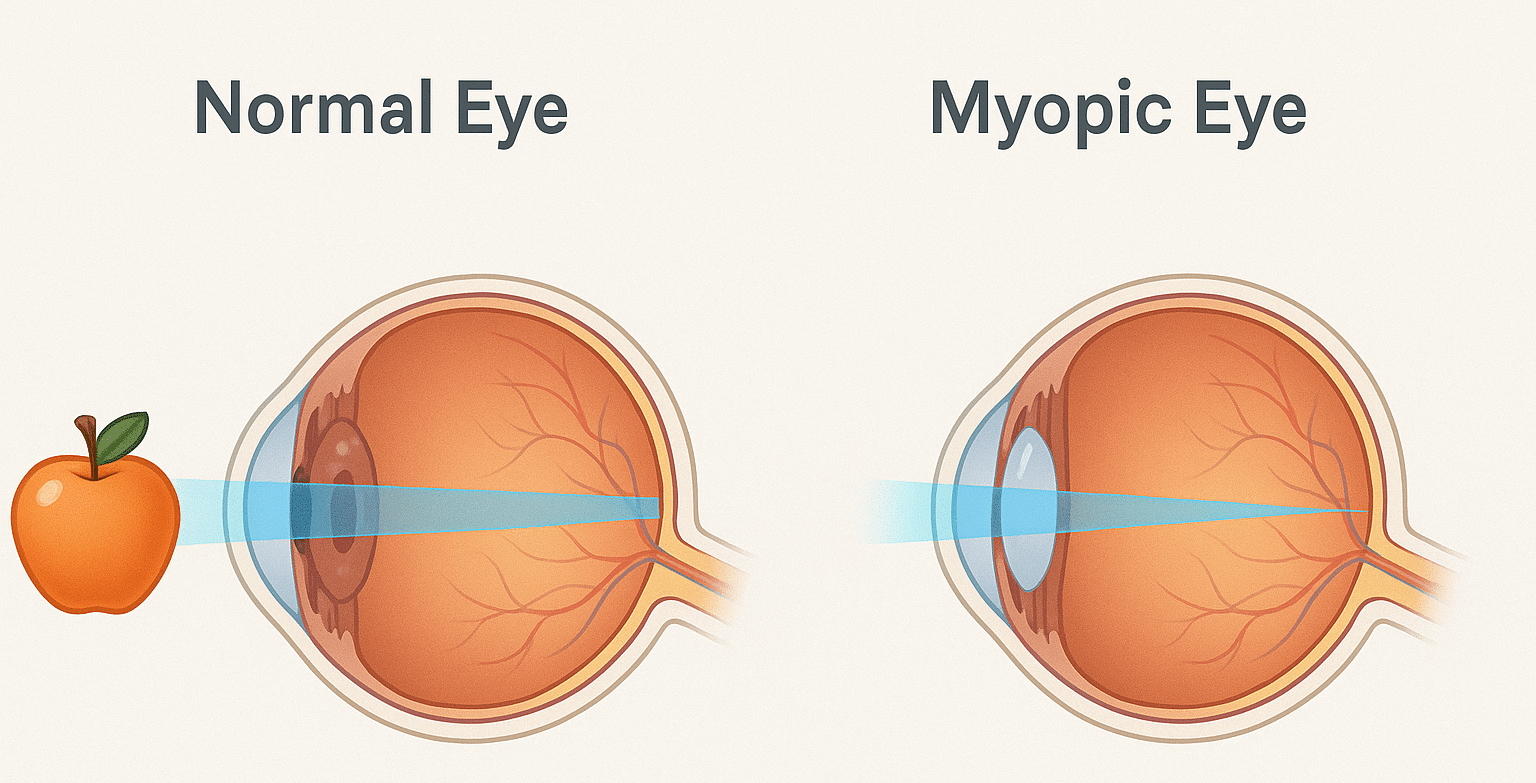Nearsightedness, or myopia, affects over 40% of the British population and is on the rise globally. This vision condition occurs when the eyes cannot focus light correctly, causing distant objects to appear blurry while nearby objects remain clear. This makes far away objects look blurry while close things stay clear. The condition has become a major health concern, affecting 33% of people. Nearsightedness has become a widespread concern, with lifestyle and environmental factors contributing to its growing prevalence among the population.
Important Points
- Prevalence: More than 40% of people in the UK are nearsighted, and the numbers are increasing worldwide.
- Vision Impact: Myopia makes it difficult to see distant objects clearly, though close-up vision remains sharp.
- Progression: The condition typically worsens until the eyes finish growing, often stabilizing in early adulthood.
- Lifestyle Factors: Spending less time outdoors and increased screen time or close-up work are linked to a higher risk of developing myopia.
Laser eye surgery, such as LASIK (Laser-Assisted In Situ Keratomileusis), is a widely used and effective treatment for correcting myopia in adults. This surgical procedure reshapes the cornea, allowing light entering the eye to be properly focused onto the retina, which can significantly reduce or eliminate the need for glasses or contact lenses.

What is Myopia and How It Affects Your Vision
You might have noticed that objects in the distance look blurry while things close to you stay crystal clear. This visual phenomenon describes myopia, a common eye condition affecting nearly one in three adults in the UK. Learning about this vision disorder’s mechanics explains why distant objects become unclear and what solutions exist.
What is myopia in the eye?
Your eye’s shape can prevent light from focusing correctly on the retina when you have myopia. Light rays meet at a point in front of the retina instead of landing precisely on this light-sensitive tissue at your eye’s back. This focusing error usually happens because the eyeball extends too far from front to back. Sometimes the cornea’s (the clear front cover of your eye) excessive curve causes the problem. Picture your eye as a slightly misadjusted camera. Light entering a myopic eye gets bent too strongly by the lens system.
This creates a clear image before it reaches the retina. The light rays start to spread out again by the time they hit your retina, which results in a blurry image. Myopia typically develops during childhood, usually between ages 6 and 13. It might continue to worsen throughout adolescence until it stabilises around age 20. Some people can develop myopia during adulthood due to visual stress or specific health conditions.

Difference between myopia and other vision issues
Myopia belongs to a group of refractive errors that change how your eyes focus light. These conditions differ mainly in where and how light focuses relative to your retina. Hyperopia (farsightedness) works differently from myopia – light focuses behind the retina rather than in front of it. This occurs because the eyeball is too short or the cornea isn’t curved enough. People with hyperopia see distant objects more clearly than nearby ones—exactly opposite to myopia.
Astigmatism creates another common vision problem. The cornea or lens curves more steeply in one direction than another. Unlike myopia or hyperopia, astigmatism makes vision distorted or blurry at every distance, not just far or near.
Here’s how these conditions compare:
| Condition | Focus Point | Clear Vision | Blurry Vision | Lens Correction |
|---|---|---|---|---|
| Myopia | In front of retina | Near objects | Distant objects | Negative power lenses |
| Hyperopia | Behind retina | Distant objects | Near objects | Positive power lenses |
| Astigmatism | Multiple focal points | Potentially blurry at all distances | Potentially blurry at all distances | Cylindrical correction |
What is short sighted vs long sighted
“Short-sighted” and “long-sighted” mean the same as myopia and hyperopia in British English. Short-sighted (myopic) people see things up close clearly but struggle with distant objects. Reading a book comes easily, but viewing street signs becomes difficult without correction.
Long-sighted (hyperopic) people generally see distant objects clearly, while close-up tasks like reading or using smartphones become challenging. Most children start life somewhat long-sighted, but their vision improves naturally as their eyes develop.
A rare condition called antimetropia makes it possible to be short-sighted in one eye and long-sighted in the other. This mixed refractive state needs specialised correction. Uncorrected myopia can significantly affect daily life. Simple tasks like recognising faces across rooms, driving, or watching television become frustrating challenges. Children might struggle with learning if they can’t see the board clearly.
Precision Vision London offers complete eye examinations to determine your myopia’s exact nature and degree, which allows for precisely tailored correction options. Myopia can’t be “cured” traditionally, but proper treatment helps you see clearly at any distance.
Recognising the Symptoms of Myopia
Detecting myopia early can make a huge difference in managing this common vision condition. Struggling with blurry distance vision? Myopia is common—but highly treatable. Let’s look at the key signs that show you or your loved ones might be short-sighted.
Blurry distance vision
You’ll notice the first sign of myopia when distant objects become hard to see clearly. People who are short-sighted can see things up close perfectly well, but their distance vision becomes blurry. This happens because light focuses in front of the retina instead of directly on it. You might find yourself unable to read road signs, see the whiteboard in school, or watch TV from across the room.
Squinting or eye strain
Squinting often reveals the first hints of myopia. Your eyes naturally try this response to make things clearer by reducing the size of the blurred image on your retina. Eye strain happens because your eyes keep trying to focus properly. The strain gets worse after you spend long periods looking at distant objects.
Frequent headaches or eye rubbing
Headaches rank among the most common symptoms when myopia goes uncorrected. These happen because your eyes strain constantly from blurry vision and squinting. On top of that, people with myopia tend to rub their eyes often—they don’t realise they’re doing this to relieve discomfort and tiredness from visual strain.
Signs in adults
Adults sometimes develop myopia because of lifestyle factors like spending too much time doing close-up work. Adult symptoms show up differently, especially when driving at night or trying to read store signs from a distance.A complete eye examinations that can catch myopia before it affects your daily life. Finding it early means, it can be treated with plans that work best for your needs.
What Causes Myopia to Develop and Worsen
Learning about why myopia happens helps us understand how it develops and gets worse. Your risk of becoming short-sighted depends on several factors working together. Knowing these factors can help prevent the condition from developing.
Genetic factors and family history
Your family’s eye health history plays a big role in your myopia risk. Kids with one parent who has myopia are twice as likely to develop it. Those with two myopic parents face five times the risk. Twin studies show that genes account for 50% to 90% of myopia cases. All the same, genes can’t be the only reason for the quick rise in myopia worldwide. This suggests our environment also affects our vision.
Too much screen time and near work
Our digital world creates new risks for eye health. Each extra hour you spend looking at screens daily makes you 21% more likely to develop myopia. Reading non-stop for more than 30 minutes or holding books closer than 30 cm doubles your risk. We found that your eyes react to how long and how intensely you focus on close objects, whatever the source.
Lack of outdoor exposure
Time spent outdoors helps protect your eyes from myopia. Every extra hour outside each week lowers your myopia risk by 2%. More than this, bright light above 3000 lux for at least 40 minutes daily can slow eye lengthening. This protection might happen because bright light triggers chemical signals in your retina that control eye growth.
Eye growth and axial length changes
Your eyes develop myopia when they grow too long from front to back. Children without myopia usually see their eyes grow 0.1-0.2mm each year until age 12. Children developing myopia show faster growth at about 0.3mm yearly. This extra growth makes light focus in front of the retina instead of on it. Keeping axial length under 26mm is vital because longer measurements mean a much higher risk of eye problems later in life.
How Myopia is Diagnosed and Measured
A proper myopia diagnosis starts with a full eye examination to measure how light focuses in your eyes. Early detection helps create management strategies that match your needs.
Visual acuity and refraction tests
Your eye doctor starts the myopia diagnosis with a visual acuity test. You’ll read letters on a standardised eye chart from a set distance. This quick test checks if you can see 3/8-inch letters at 20 feet, which indicates 20/20 vision. Next comes a refraction test to measure your prescription needs. Your optometrist uses a device called a phoropter to place different lenses in front of your eyes and asks which ones make your vision clearer. This helps determine the exact lens strength you need to correct your myopia.
Retinoscopy and eye health checks
Retinoscopy provides objective measurements of your refractive error without needing your input. Your optometrist shines light into your eye and watches how it bounces off your retina. They adjust various lenses to determine your exact myopia level. This method works great for young children or people who might find traditional testing methods challenging.
Treatment Options for Myopia Explained
Managing myopia requires several treatment options that range from basic solutions to cutting-edge technologies. Your age, lifestyle, and how severe your short-sightedness is will determine the best treatment choice.
Eyeglasses and contact lenses
Eyeglasses and contact lenses are the most common and straightforward ways to correct myopia. These visual aids adjust how light enters your eye and help focus it properly on the retina. Adults can use glasses. Contact lenses work better for adults. These options won’t slow down myopia progression but they give you clear vision right away.
Orthokeratology (Ortho-k)
Ortho-k gives you a great alternative to wearing glasses during the day. You wear these special rigid contact lenses while you sleep, and they reshape your cornea gently. The next day, you can see clearly without any glasses or contacts. Research shows that Ortho-k helps slow down myopia progression.
Laser eye surgery and LASIK
Laser eye surgery changes your cornea’s shape forever to fix short-sightedness. LASIK (Laser-Assisted In Situ Keratomileusis) creates a thin flap in your cornea. A laser reshapes the tissue underneath. This treatment works great for mild to moderate myopia. More than 8 out of 10 people achieve 20/20 vision or better after the procedure.
Refractive surgery for high myopia
People with severe short-sightedness above -10.00D have other options available:
- Phakic intraocular lenses (IOLs) implanted without removing the natural lens
- Refractive lens exchange (RLE) where we replace the natural lens with an artificial one
How to cure myopia – is it possible?
Modern treatments can’t “cure” myopia—they can only correct it. Once your eye elongates, treatments can stop it from getting worse and fix your vision. The structural changes that already happened can’t be reversed. Starting treatment early is crucial to manage myopia well.
How Precision Vision London Can Help Manage Myopia
Your long-term eye health can be substantially improved with proactive myopia management. Precision Vision London provides complete solutions that match your specific needs and follow evidence-based practises.
Personalised myopia control plans
Myopia develops differently in each person. We get a full picture to determine progression rates before suggesting treatment. Our specialists think over your genetic background, environmental factors, and lifestyle to create a customised plan. We make sure you understand that myopia can be managed, not just corrected.
Advanced diagnostic tools
State-of-the-art technology at Precision Vision London measures and tracks myopia progression with precision. We start with complete eye examinations and detailed axial length measurements. Keeping axial length below 26mm is a vital factor that substantially reduces future eye problems. Our advanced equipment tracks your eye’s changes over time and helps us fine-tune your treatment plan.
Ongoing monitoring and support
Everything in tracking progress needs follow-ups every 6-12 months to measure progression and adjust treatment. We guide you through lifestyle changes like spending at least one hour outdoors daily and taking regular breaks during near work. Precision Vision London helps you see clearly with personalised solutions. Book your eye assessment today.
Conclusion
Myopia rates in the UK keep rising, and now affect nearly one in three adults. Your vision health depends on understanding this condition well. While there’s no complete cure for myopia, you have many options to correct your vision and slow its progression. Regular detailed eye exams can catch myopia before it gets worse. Simple changes in daily life make a big difference too. More time outdoors and less close-up work help manage the condition better.
Precision Vision London’s detailed approach has precise axial length measurements, custom treatment plans, and regular checks to monitor changes. Their advanced options include Laser eye surgery or Lens replacement surgery
Managing myopia is an ongoing experience, not a quick fix. Your treatment plan needs regular reviews and updates to work best. With good care and expert guidance, you can maintain clear vision despite having myopia.
Key Takeaways
Understanding myopia is crucial as it affects nearly one in three adults in the UK and is rapidly increasing worldwide, particularly amongst children.
- Myopia occurs when your eyeball is too long, causing light to focus in front of the retina rather than on it, making distant objects blurry whilst near vision remains clear.
- Key warning signs include squinting, frequent headaches, eye strain, and difficulty seeing distant objects like road signs or whiteboards at school.
- Excessive screen time and insufficient outdoor exposure are major risk factors—each hour outdoors weekly reduces myopia odds by 2%.
- Modern treatments like orthokeratology lenses can slow progression by up to 50% , preventing future complications.
- Regular eye examinations every two years enable early detection and personalised management plans that go beyond simple vision correction to actively control progression.
FAQs
Q1. What exactly is myopia and how does it affect vision? Myopia, or short-sightedness, is a condition where distant objects appear blurry while close objects remain clear. It occurs when the eye is too long or the cornea is too curved, causing light to focus in front of the retina instead of directly on it.
Q2. At what age does myopia typically develop? Myopia usually begins in childhood, often between the ages of 6 and 13. It may continue to worsen throughout adolescence until stabilising around age 20, although in some cases it can also develop during adulthood.
Q3. Can myopia be cured? While myopia cannot be truly “cured”, it can be effectively managed and corrected. Various treatments can halt progression and correct vision, but they cannot reverse the structural changes that have already occurred in the eye.
Q4. What are some effective treatments for managing myopia? Effective treatments include traditional options like eyeglasses and contact lenses, as well as more advanced solutions such as orthokeratology (Ortho-k) lenses, and in some cases, laser eye surgery or refractive surgery for high myopia.
Q5. How can lifestyle changes help in managing myopia? Lifestyle modifications can play a crucial role in managing myopia. Increasing outdoor time to at least one hour daily and taking regular breaks during near work can help. Additionally, reducing excessive screen time and maintaining proper reading distances (more than 30 cm) may lower the risk of myopia progression.
Authors & Reviewer
-
 Olivia: Author
Olivia: AuthorHi, I'm Olivia, a passionate writer specialising in eye care, vision health, and the latest advancements in optometry. I strive to craft informative and engaging articles that help readers make informed decisions about their eye health. With a keen eye for detail and a commitment to delivering accurate, research-backed content, I aim to educate and inspire through every piece I write.
-
 Dr. CT Pillai: Reviewer
Dr. CT Pillai: ReviewerDr. CT Pillai is a globally recognised ophthalmologist with over 30 years of experience, specialising in refractive surgery and general ophthalmology. Renowned for performing over 50,000 successful laser procedures.

